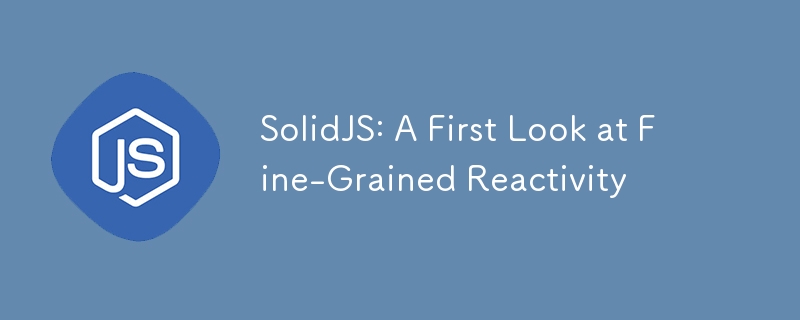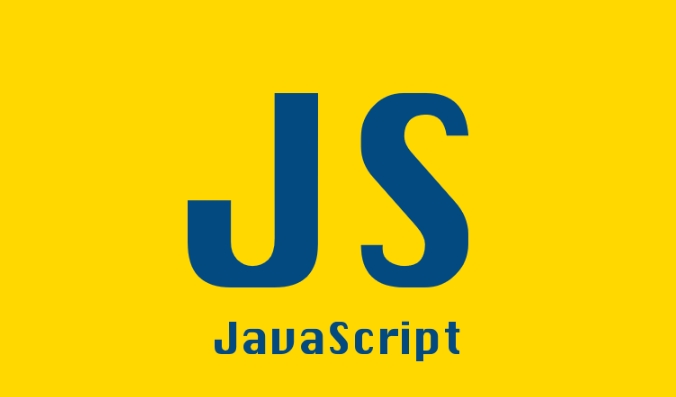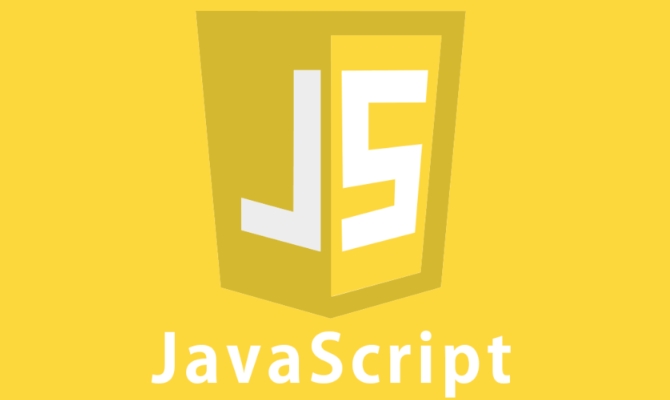SolidJS: A First Look at Fine-Grained Reactivity
Jul 30, 2025 am 04:31 AM <p> SolidJS is a striking existence in the front-end framework ecosystem in recent years. If you are familiar with React but are a little dissatisfied with its "re-rendering" mechanism and the performance overhead of virtual DOM, SolidJS provides a different idea: true Fine-Grained Reactivity . It does not rely on the diff algorithm or the virtual DOM, but it can accurately update the smallest units in the UI at runtime.
<p> SolidJS is a striking existence in the front-end framework ecosystem in recent years. If you are familiar with React but are a little dissatisfied with its "re-rendering" mechanism and the performance overhead of virtual DOM, SolidJS provides a different idea: true Fine-Grained Reactivity . It does not rely on the diff algorithm or the virtual DOM, but it can accurately update the smallest units in the UI at runtime.

What is a fine-grained responsive?
<p> In React, the status update triggers the component function to be re-rendered, and then the virtual DOM diff is used to find the DOM node that needs to be changed. Although this process is efficient, it is essentially "coarse-grained" - the entire component function has to be run, even if only one variable is changed. <p> SolidJS's responsive system is "fine-grained": it establishes an exact dependency between state and DOM nodes when it is rendered for the first time . When a certain state changes, the framework can directly locate the part of the DOM that needs to be updated, skipping all unrelated calculations and traversals. <p> To give a simple example:
<p> To give a simple example: function Counter() {
const [count, setCount] = createSignal(0);
Return (
<div>
<p>Count: {count()}</p>
<button onClick={() => setCount(count() 1)}>Increment</button>
</div>
);
}<p> In this example, {count()} is considered a responsive dependency. Solid automatically tracks it when rendering and creates a "side effect" to listen for changes. Once setCount is called, only the text in the <p> tag will be updated, and the rest (such as the button) will remain unmoved at all. 
How to update efficiently without a virtual DOM?
<p> This is the most surprising thing about SolidJS: It does not use virtual DOM at all .<p> Instead, Solid converts JSX to direct instructions to manipulate real DOM at compile time (with Babel or SWC). Each responsive expression is compiled into a traceable "signal" and bound to the specific DOM node.<p> This means:- Fast rendering for the first time (no VDOM build overhead)
- Updates very quickly (update text nodes or attributes directly)
- Lower memory footprint (no maintenance of VDOM tree)
Responsive principles: Signals, Effects, and Memos
<p> Solid's responsive system is based on three core concepts:- Signals : Stores variable states and notifies the dependant when changes are made.
- Effects : Side effect function (such as updating the DOM), automatically tracking dependent signals.
- Memorizations (Memo) : caches the calculation results and recalculates only when dependency changes.
const [count, setCount] = createSignal(0);
const doubled = createMemo(() => count() * 2);
createEffect(() => {
console.log("Count changed:", count());
});-
createMemois only re-executes whencount()changes. -
createEffectruns when component initialization and reruns after eachcount()change. - All dependencies are automatically established at runtime without manual declaration.
JSX and templates: written like React, behave like Svelte
<p> Solid's JSX looks a lot like React, but behaves closer to Svelte or Angular:- <p> Conditional rendering requires the
Showcomponent:<Show when={count() > 5}> <p>Count is big!</p> </Show> - <p>
Forlist rendering:<For each={list()}> {(item) => <div>{item.name}</div>} </For><p> These are not ordinary components, but control flow structures identified at compile time, which can generate efficient responsive update logic.Why is it worth paying attention to?
- Excellent performance : JS Framework Benchmark has been ranked first for a long time.
- Small size : The production package is about 6KB, no virtual DOM.
- Writing is close to React : low learning cost, JSX Hooks style.
- True responsiveness : Not component-based updates, but data-dependent updates.
summary
<p> SolidJS is not another "React-like" framework, but a rethinking of responsive UI. It replaces immutable state with Signals, replaces runtime diff with compile-time optimization, and replaces component-level re-render with fine-grained updates. <p> If you pursue extreme performance, but don't want to write complex template syntax or give up the flexibility of JSX, SolidJS is a very worthwhile choice. <p> Basically that's it - no magic, only clear responsive models and clever compilation strategies.The above is the detailed content of SolidJS: A First Look at Fine-Grained Reactivity. For more information, please follow other related articles on the PHP Chinese website!

Hot AI Tools

Undress AI Tool
Undress images for free

Undresser.AI Undress
AI-powered app for creating realistic nude photos

AI Clothes Remover
Online AI tool for removing clothes from photos.

Clothoff.io
AI clothes remover

Video Face Swap
Swap faces in any video effortlessly with our completely free AI face swap tool!

Hot Article

Hot Tools

Notepad++7.3.1
Easy-to-use and free code editor

SublimeText3 Chinese version
Chinese version, very easy to use

Zend Studio 13.0.1
Powerful PHP integrated development environment

Dreamweaver CS6
Visual web development tools

SublimeText3 Mac version
God-level code editing software (SublimeText3)
 React vs. Vue: Which Framework Does Netflix Use?
Apr 14, 2025 am 12:19 AM
React vs. Vue: Which Framework Does Netflix Use?
Apr 14, 2025 am 12:19 AM
Netflixusesacustomframeworkcalled"Gibbon"builtonReact,notReactorVuedirectly.1)TeamExperience:Choosebasedonfamiliarity.2)ProjectComplexity:Vueforsimplerprojects,Reactforcomplexones.3)CustomizationNeeds:Reactoffersmoreflexibility.4)Ecosystema
 React's Ecosystem: Libraries, Tools, and Best Practices
Apr 18, 2025 am 12:23 AM
React's Ecosystem: Libraries, Tools, and Best Practices
Apr 18, 2025 am 12:23 AM
The React ecosystem includes state management libraries (such as Redux), routing libraries (such as ReactRouter), UI component libraries (such as Material-UI), testing tools (such as Jest), and building tools (such as Webpack). These tools work together to help developers develop and maintain applications efficiently, improve code quality and development efficiency.
 Netflix's Frontend: Examples and Applications of React (or Vue)
Apr 16, 2025 am 12:08 AM
Netflix's Frontend: Examples and Applications of React (or Vue)
Apr 16, 2025 am 12:08 AM
Netflix uses React as its front-end framework. 1) React's componentized development model and strong ecosystem are the main reasons why Netflix chose it. 2) Through componentization, Netflix splits complex interfaces into manageable chunks such as video players, recommendation lists and user comments. 3) React's virtual DOM and component life cycle optimizes rendering efficiency and user interaction management.
 React: The Power of a JavaScript Library for Web Development
Apr 18, 2025 am 12:25 AM
React: The Power of a JavaScript Library for Web Development
Apr 18, 2025 am 12:25 AM
React is a JavaScript library developed by Meta for building user interfaces, with its core being component development and virtual DOM technology. 1. Component and state management: React manages state through components (functions or classes) and Hooks (such as useState), improving code reusability and maintenance. 2. Virtual DOM and performance optimization: Through virtual DOM, React efficiently updates the real DOM to improve performance. 3. Life cycle and Hooks: Hooks (such as useEffect) allow function components to manage life cycles and perform side-effect operations. 4. Usage example: From basic HelloWorld components to advanced global state management (useContext and
 The Future of React: Trends and Innovations in Web Development
Apr 19, 2025 am 12:22 AM
The Future of React: Trends and Innovations in Web Development
Apr 19, 2025 am 12:22 AM
React's future will focus on the ultimate in component development, performance optimization and deep integration with other technology stacks. 1) React will further simplify the creation and management of components and promote the ultimate in component development. 2) Performance optimization will become the focus, especially in large applications. 3) React will be deeply integrated with technologies such as GraphQL and TypeScript to improve the development experience.
 Frontend Development with React: Advantages and Techniques
Apr 17, 2025 am 12:25 AM
Frontend Development with React: Advantages and Techniques
Apr 17, 2025 am 12:25 AM
The advantages of React are its flexibility and efficiency, which are reflected in: 1) Component-based design improves code reusability; 2) Virtual DOM technology optimizes performance, especially when handling large amounts of data updates; 3) The rich ecosystem provides a large number of third-party libraries and tools. By understanding how React works and uses examples, you can master its core concepts and best practices to build an efficient, maintainable user interface.
 React, Vue, and the Future of Netflix's Frontend
Apr 12, 2025 am 12:12 AM
React, Vue, and the Future of Netflix's Frontend
Apr 12, 2025 am 12:12 AM
Netflix mainly uses React as the front-end framework, supplemented by Vue for specific functions. 1) React's componentization and virtual DOM improve the performance and development efficiency of Netflix applications. 2) Vue is used in Netflix's internal tools and small projects, and its flexibility and ease of use are key.
 React vs. Backend Frameworks: A Comparison
Apr 13, 2025 am 12:06 AM
React vs. Backend Frameworks: A Comparison
Apr 13, 2025 am 12:06 AM
React is a front-end framework for building user interfaces; a back-end framework is used to build server-side applications. React provides componentized and efficient UI updates, and the backend framework provides a complete backend service solution. When choosing a technology stack, project requirements, team skills, and scalability should be considered.






